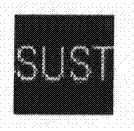Digital image watermark extraction method based on DCT algorithm
A technology of digital image and watermark extraction
- Summary
- Abstract
- Description
- Claims
- Application Information
AI Technical Summary
Problems solved by technology
Method used
Image
Examples
Embodiment 1
[0046] Taking an image with a size of 128×128 pixels as an example to illustrate the implementation steps of this embodiment:
[0047] The first step is to read the original image and the watermarked image with a size of 128×128 pixels, and divide them into 32×32 image blocks that do not cover each other, and perform DCT domain transformation on the original image and the image to be tested respectively. Perform difference calculations to determine sequence positions:
[0048] Embedding rule: v′ i =v i (1+αw i )
[0049] Corresponding extraction rule: v′ i -v i =αv i w i
[0050] where v i , v' i are the frequency domain coefficients before and after modification, respectively, α is the stretching coefficient, w i is the i-th information bit watermark;
[0051] In the second step, the variance of the image blocks is compared, and the texture blocks are separated, so as to determine the position where the watermark is embedded in the image:
[0052] When extracting...
Embodiment 2
[0064] Taking an image with a size of 256×256 pixels as an example to illustrate the implementation steps of this embodiment:
[0065] The first step is to read the original image and the watermarked image with a size of 256×256 pixels, and divide them into 32×32 image blocks that do not cover each other. The original image and the image to be tested are respectively subjected to DCT domain transformation, and the difference calculation is performed to determine the sequence position:
[0066] Embedding rule: v' i =v i (1+αw i )
[0067] Corresponding extraction rule: v′ i -v i =αv i w i
[0068] where v i , v' i are the frequency domain coefficients before and after modification, respectively, α is the stretching coefficient, w i is the i-th information bit watermark;
[0069] In the second step, the variance of the image blocks is compared, and the texture blocks are separated, so as to determine the position where the watermark is embedded in the image:
[0070...
Embodiment 3
[0082] Taking an image with a size of 512×512 pixels as an example to illustrate the implementation steps of this embodiment:
[0083] The first step is to read the original image and the watermarked image with a size of 512×512 pixels, and divide them into 64×64 image blocks that do not cover each other. The original image and the image to be tested are respectively subjected to DCT domain transformation, and the difference calculation is performed to determine the sequence position:
[0084] Embedding rule: v' i =v i (1+αw i )
[0085] Corresponding extraction rule: v′ i -v i =αv i w i
[0086] where v i , v' i are the frequency domain coefficients before and after modification, respectively, α is the stretching coefficient, w i is the i-th information bit watermark;
[0087] In the second step, the variance of the image blocks is compared, and the texture blocks are separated, so as to determine the position where the watermark is embedded in the image:
[0088...
PUM
 Login to View More
Login to View More Abstract
Description
Claims
Application Information
 Login to View More
Login to View More - R&D
- Intellectual Property
- Life Sciences
- Materials
- Tech Scout
- Unparalleled Data Quality
- Higher Quality Content
- 60% Fewer Hallucinations
Browse by: Latest US Patents, China's latest patents, Technical Efficacy Thesaurus, Application Domain, Technology Topic, Popular Technical Reports.
© 2025 PatSnap. All rights reserved.Legal|Privacy policy|Modern Slavery Act Transparency Statement|Sitemap|About US| Contact US: help@patsnap.com



